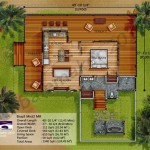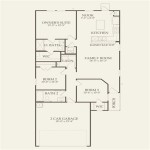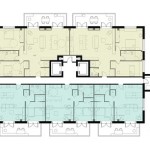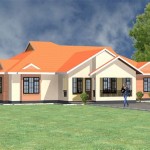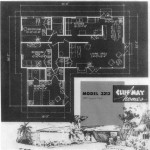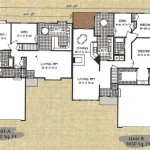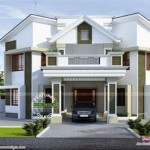4 Bedroom House Plan: Achieving Low Cost Construction
Designing and building a four-bedroom house can be a significant undertaking, particularly when budgetary constraints are a primary concern. A "4 bedroom house plan low cost" approach requires careful planning, strategic material selection, and an understanding of design principles that minimize expenses without sacrificing functionality or structural integrity. This article explores key considerations for developing a budget-friendly four-bedroom house plan, focusing on design choices, material options, and construction techniques.
Optimizing the Floor Plan for Cost Efficiency
The floor plan is the foundation of any house design, and its efficiency directly impacts construction costs. Simple shapes, such as squares or rectangles, are generally more cost-effective to build than complex geometries. Minimizing the number of corners and protrusions reduces the amount of framing, sheathing, and finishing materials required. A compact footprint can also lead to lower foundation and roofing expenses.
Open-concept layouts, where living areas flow seamlessly into each other, can reduce the need for interior walls, thereby decreasing material costs and labor time. This design also enhances natural light distribution, potentially lowering energy consumption for lighting. However, careful consideration must be given to sound control and privacy in open-concept spaces.
Strategic placement of bedrooms is crucial. Grouping bedrooms together can simplify plumbing and electrical runs, minimizing material and labor costs. A two-story design, while potentially requiring more structural engineering, can significantly reduce the footprint of the house, leading to lower foundation and roofing expenses compared to a single-story structure with the same square footage. However, the increased cost of stair construction must be factored into the overall budget.
Minimizing hallway space is another effective cost-saving measure. Hallways are typically non-functional spaces that add to the overall square footage without providing direct living space. Careful planning can integrate circulation paths into living areas, reducing the need for dedicated hallways and optimizing the use of available space.
Consider the placement of windows and doors. Standard sizes are generally more affordable than custom sizes. Limiting the number of windows and doors can reduce material costs and labor time. However, it's essential to balance cost savings with the need for adequate natural light and ventilation.
Selecting Cost-Effective Building Materials
The choice of building materials significantly influences the overall cost of construction. Opting for locally sourced materials can reduce transportation costs and support local economies. Exploring alternative materials, such as engineered wood products, can offer cost savings compared to traditional lumber.
Concrete blocks (CMUs) are a cost-effective alternative to traditional brick or stone for foundation walls. They offer durability and structural stability at a lower price point. When considering exterior cladding, vinyl siding is often a more affordable option than brick or natural stone. It is also low-maintenance and comes in a variety of colors and styles.
For roofing, asphalt shingles are generally the most economical choice. They are readily available, easy to install, and offer adequate protection against the elements. Metal roofing, while more expensive initially, can offer long-term cost savings due to its durability and longevity, potentially reducing the need for future replacements.
Interior finishes also contribute significantly to the overall cost. Opting for cost-effective flooring options, such as laminate or vinyl flooring, can significantly reduce expenses compared to hardwood or tile. Simple paint finishes are generally more affordable than textured finishes or wallpaper. Choosing standard-sized tiles for bathrooms and kitchens can minimize waste and installation costs.
When selecting plumbing and electrical fixtures, consider energy-efficient models. While they may have a higher upfront cost, they can lead to long-term savings on utility bills. Opting for standard fixture finishes can also help control costs.
Employing Cost-Efficient Construction Techniques
The method of construction can also impact the overall cost of building a four-bedroom house. Stick-built construction, where the house is framed on site, is a common and often cost-effective method. However, pre-fabricated construction methods, such as modular or panelized construction, can offer potential cost savings by reducing labor time and material waste.
Simple framing techniques, such as using 2x4 lumber for non-load-bearing walls, can reduce material costs. Optimizing the spacing of framing members can also minimize lumber usage. Careful planning to minimize material waste is crucial. This includes accurately calculating material quantities, ordering only what is needed, and utilizing cut-offs effectively.
Proper insulation is essential for energy efficiency and can lead to long-term cost savings on heating and cooling. Opting for cost-effective insulation materials, such as fiberglass or cellulose, can provide adequate thermal performance without breaking the bank. Air sealing is also crucial for preventing air leaks and improving energy efficiency.
Consider incorporating passive solar design principles to reduce reliance on mechanical heating and cooling systems. This includes orienting the house to maximize solar gain in the winter and minimize solar gain in the summer, using overhangs to shade windows, and incorporating natural ventilation strategies.
DIY (Do-It-Yourself) projects can also contribute to cost savings, but it's essential to be realistic about your skills and abilities. Tasks such as painting, landscaping, and some finish carpentry work can be completed by homeowners to reduce labor costs. However, it's crucial to hire licensed professionals for tasks that require specialized skills or knowledge, such as electrical wiring, plumbing, and structural work.
Effective project management is crucial for controlling costs. This includes developing a detailed budget, creating a realistic schedule, and closely monitoring expenses throughout the construction process. Hiring a qualified general contractor can help ensure that the project stays on track and within budget.
Value engineering is a systematic process of reviewing the design and construction plans to identify potential cost savings without sacrificing functionality or quality. This can involve exploring alternative materials, construction techniques, or design features. A value engineering analysis can help identify opportunities to reduce costs without compromising the integrity of the house.
Contingency planning is essential for any construction project. Setting aside a contingency fund to cover unexpected expenses or unforeseen issues can help prevent cost overruns. A contingency fund of 5-10% of the total project cost is generally recommended.
In summary, achieving a low-cost four-bedroom house plan requires a strategic approach that encompasses thoughtful design, careful material selection, and efficient construction techniques. By optimizing the floor plan, utilizing cost-effective materials, and employing efficient construction methods, it is possible to build a functional and affordable four-bedroom house without compromising quality or structural integrity.

4 Bedroom Small Plot Home Design With Free Plan

Budget Friendly 4 Bed House Plan 55150br Architectural Designs Plans

Cost Effective 4 Bedroom Modern Home In Low Budget Free Plan

4 Bedroom House Plan In Village Bhk Home Plans Simple Low Budget

Building On The Affordable House Plans Of 2024 Houseplans Blog Com

4 Bedroom House Plan Examples

Est House Plans To Build Simple With Style Blog Eplans Com

House Design Plan 12x9 5m With 4 Bedrooms Home Ideas 9bc

New 4 Bedroom House Plans In Kenya 0718552405

Low Budget Simple House Design Plans For Builders Blog Builderhouseplans Com

